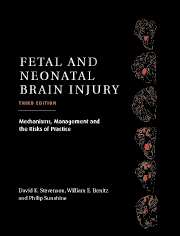Book contents
- Frontmatter
- Contents
- List of contributors
- Foreword
- Preface
- Part I Epidemiology, Pathophysiology, and Pathogenesis of Fetal and Neonatal Brain Injury
- Part II Pregnancy, Labor, and Delivery Complications Causing Brain Injury
- 9 Maternal diseases that affect fetal development
- 10 Antepartum evaluation of fetal well-being
- 11 Intrapartum evaluation of the fetus
- 12 Obstetrical conditions and practices that affect the fetus and newborn
- 13 Fetal and neonatal injury as a consequence of maternal substance abuse
- 14 Chorioamnionitis and its possible relation to subsequent cerebral palsy
- 15 Bacterial sepsis in the neonate
- 16 Neonatal bacterial meningitis
- 17 Neurological sequelae of congenital perinatal infection
- 18 Perinatal human immunodeficiency virus infection
- 19 Inborn errors of metabolism with features of hypoxic–ischemic encephalopathy
- Part III Diagnosis of the Infant with Asphyxia
- Part IV Specific Conditions Associated with Fetal and Neonatal Brain Injury
- Part V Management of the Depressed or Neurologically Dysfunctional Neonate
- Part VI Assessing the Outcome of the Asphyxiated Infant
- Index
- Plate section
16 - Neonatal bacterial meningitis
from Part II - Pregnancy, Labor, and Delivery Complications Causing Brain Injury
Published online by Cambridge University Press: 10 November 2010
- Frontmatter
- Contents
- List of contributors
- Foreword
- Preface
- Part I Epidemiology, Pathophysiology, and Pathogenesis of Fetal and Neonatal Brain Injury
- Part II Pregnancy, Labor, and Delivery Complications Causing Brain Injury
- 9 Maternal diseases that affect fetal development
- 10 Antepartum evaluation of fetal well-being
- 11 Intrapartum evaluation of the fetus
- 12 Obstetrical conditions and practices that affect the fetus and newborn
- 13 Fetal and neonatal injury as a consequence of maternal substance abuse
- 14 Chorioamnionitis and its possible relation to subsequent cerebral palsy
- 15 Bacterial sepsis in the neonate
- 16 Neonatal bacterial meningitis
- 17 Neurological sequelae of congenital perinatal infection
- 18 Perinatal human immunodeficiency virus infection
- 19 Inborn errors of metabolism with features of hypoxic–ischemic encephalopathy
- Part III Diagnosis of the Infant with Asphyxia
- Part IV Specific Conditions Associated with Fetal and Neonatal Brain Injury
- Part V Management of the Depressed or Neurologically Dysfunctional Neonate
- Part VI Assessing the Outcome of the Asphyxiated Infant
- Index
- Plate section
Summary
Introduction
The term “meningitis” refers to inflammation of the leptomeninges covering the brain. Bacterial infection of the meninges usually produces a suppurative process or “purulent meningitis.” However, it is probably more correct in the newborn infant to consider the condition as bacterial meningoencephalitis, since it is common to have involvement of the cerebral hemispheres as well as involvement of the meninges.
From the clinician's perspective it has been traditional to think of neonatal sepsis (septicemia) and meningitis together, because the clinical manifestations may be indistinguishable. For many years, the proportion of cases of neonatal sepsis that also had documented meningitis was considered to be one-quarter to one-third. For instance, in 1986 it was estimated that one case of neonatal meningitis occurs for every four cases of sepsis. Indeed, this was my personal experience in Vermont between 1975 and 1980, when 12 of 41 cases (29%) with neonatal sepsis in the first week after birth had associated meningitis. However, in recent years the proportion of cases seems to be decreasing to as low as 5%. This may be less true in other countries, with 32 of 229 (14%) noted in Israel, and 107 of 577 (18.5%) in Panama.
Incidence
The incidence of neonatal bacterial meningitis will vary from one center to the next, but national studies have shown the incidence to be quite similar (Table 16.1).
- Type
- Chapter
- Information
- Fetal and Neonatal Brain InjuryMechanisms, Management and the Risks of Practice, pp. 333 - 354Publisher: Cambridge University PressPrint publication year: 2003
- 1
- Cited by

